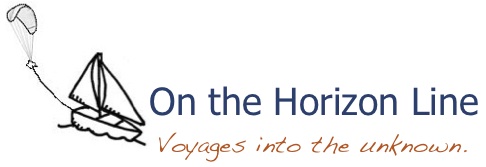We’re Halfway There on This Gyrating Merry-Go-Round
A gyrating merry-go-round,
we teeter-totter across the sea.
60,000 pounds of steel turned tiny rubber duckie at the whim of wandering waves.
The American flag whips in tatters, the stripes stripped into ragged ribbons.
Persevering. Presiding. Present.
Like the rest of us.
Each day a repeat of the next or the last
until the uneven rhythm of teeter-tottering echoes through
every cell, meal, word, step, dream.
Until — after 1,000 miles — you want to scream:
At the flogging sails snapping against your sunbaked nerves.
At your sleeping-again seasick husband leaving you to jellyfish stings in seawater dish suds.
Until — after 2,000 miles — you want to sing:
To the dolphins dancing in moonlight and the single orca that surfaces alongside.
To the power of passing squalls that bequeath gin-clear drops to drink.
Noise become your constant companion:
The goblin-growl of the groaning auto-pilot, the rattle of loose pots, the whistle of rigging.
The slide of hanging clothes, the swoosh of waves over your head as you sleep.
Back and forth, forth and back. Back. Forward.
My bones rocking, gnawing, rubbing, riding, swiveling.
My brains swishing and sloshing on the gyrating merry-go-round.
We chant to the sails: keep full.
We dance for the wind: don’t leave.
We plead to the waves: stay out.
We’re halfway there: can’t you tell?
The blue water looks bluer, the white clouds whiter.
Halfway is directly below my Montana home.
Over and up, down and around.
We circle a straight course.
I circle my own midline.
It’s all the same: a movie set of false sunsets and frothy whitecaps.
There is no middle, there is no end.
Or perhaps the middle is it’s own end.
I stare at starry skies, searching for my personal revelation.
I listen to waving seas waiting to hear the meaning of life.
I taste the salt on my shoulder, in my hair, hoping it will move me to meditate.
But revelations refuse to alight on our swinging mast.
Meaning can’t break through the noise and movement.
There’s no room for mediation amidst daily survival.
You have to stay still to receive the benefit.
You have to stay still to hear the ending.
We are never still.
Only a salty slingshot slippery sliding
rolling pitching creaking rocking flogging singing laughing
forever blue merry-go-round teeter-tottering across the endless sea.































